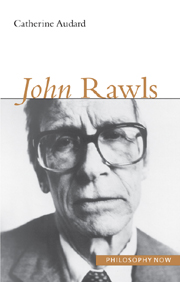Book contents
- Frontmatter
- Contents
- Acknowledgements
- Abbreviations
- Introduction
- 1 The primacy of justice
- 2 Constructing the principles of justice
- 3 Defending democratic equality: The argument from the Original Position
- 4 Pluralism and political consensus: The argument for political liberalism
- 5 A reasonable law of peoples for a real world
- Conclusion: Beyond liberalism
- Notes
- Bibliography
- Index
4 - Pluralism and political consensus: The argument for political liberalism
- Frontmatter
- Contents
- Acknowledgements
- Abbreviations
- Introduction
- 1 The primacy of justice
- 2 Constructing the principles of justice
- 3 Defending democratic equality: The argument from the Original Position
- 4 Pluralism and political consensus: The argument for political liberalism
- 5 A reasonable law of peoples for a real world
- Conclusion: Beyond liberalism
- Notes
- Bibliography
- Index
Summary
Introduction
In the second stage of the theory of justice, presented in Part III of A Theory of Justice, Rawls leaves the sphere of theoretical thinking and becomes concerned with the more political questions of feasibility and stability. Once the veil of ignorance is lifted and full information becomes available to citizens, the principles of justice and the rules of public reasoning are firmly settled (PL: 140–41). In order for the theoryof justice to be complete, we now have to address the question of its stability, of the support it will get over time from all or from a majority of citizens. The test of the theory for Rawls, given his concern for “realism”, is whether it has a fair prospect of being applicable and meeting public approval.
Rawls provides two distinct answers, which have in some ways been confused and misunderstood. The form of stabilitythat he is trying to advance has to be “moral”: it has to address people's autonomous judgement and capacities of moral reasoning. It has also to be political, but in what sense? The two answers correspond to the two requirements of morality and realism.
The first answer is centred on the motivational value of the “good of justice”. Living with just institutions will transform citizens as they experience the value of their public conception of justice. They will develop over time a sense of justice, which will create the right conditions for stability.
- Type
- Chapter
- Information
- John Rawls , pp. 175 - 228Publisher: Acumen PublishingPrint publication year: 2006



